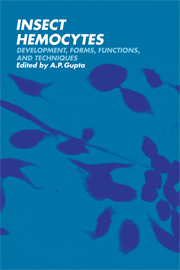Book contents
- Frontmatter
- Contents
- Preface
- List of contributors
- Part I Development and differentiation
- Part II Forms and structure
- 4 Hemocyte types: their structures, synonymies, interrelationships, and taxonomic significance
- 5 Surface and internal ultrastructure of hemocytes of some insects
- 6 Fine structure of hemocyte membranes and intercellular junctions formed during hemocyte encapsulation
- 7 Controversies about the coagulocyte
- 8 Controversies about hemocyte types in insects
- 9 Hemocyte cultures and insect hemocytology
- 10 Pathways and pitfalls in the classification and study of insect hemocytes
- Part III Functions
- Part IV Techniques
- Indexes
8 - Controversies about hemocyte types in insects
Published online by Cambridge University Press: 04 August 2010
- Frontmatter
- Contents
- Preface
- List of contributors
- Part I Development and differentiation
- Part II Forms and structure
- 4 Hemocyte types: their structures, synonymies, interrelationships, and taxonomic significance
- 5 Surface and internal ultrastructure of hemocytes of some insects
- 6 Fine structure of hemocyte membranes and intercellular junctions formed during hemocyte encapsulation
- 7 Controversies about the coagulocyte
- 8 Controversies about hemocyte types in insects
- 9 Hemocyte cultures and insect hemocytology
- 10 Pathways and pitfalls in the classification and study of insect hemocytes
- Part III Functions
- Part IV Techniques
- Indexes
Summary
Introduction
It seems strange that after almost a century of research in insect hemocytology, there is still no consensus on one of its most basic questions: Do the different forms of cells we find in the blood represent transient morphological variants of one kind of cell or constitute a number of distinctive and immutable types? If our indecision on this point seems strange, perhaps it can be forgiven if we consider that the answer requires at least some knowledge of the origins and biology of the hemocytes in a wide range of insect species. Such knowledge cannot yet be claimed, for in only a few species among about 100 genera have even superficial studies been made, and in only about 20 others has the research continued in any depth. Surprisingly, almost the entire body of research on insect hemocytes is concentrated among only 6 orders (Coleoptera, Dictyoptera, Diptera, Hemiptera, Lepidoptera, and Orthoptera) of the 25 or more in the class, and there are widely varied opinions on the status of hemocyte types in any one of them. Little wonder, then, that the subject is a contentious one.
Although this question cannot be answered to everyone's satisfaction even now, it can be examined fairly in the light of recent observations and with an attempt to eliminate ambiguities and misinterpretations that are perpetuated in the literature. This will be the approach taken here.
The status of the hemocyte types is inseparable from hemocyte classification and is bound to studies of the nature of the cells. Unfortunately, hemocyte classification is constantly in disrepute.
- Type
- Chapter
- Information
- Insect HemocytesDevelopment, Forms, Functions and Techniques, pp. 231 - 258Publisher: Cambridge University PressPrint publication year: 1979
- 8
- Cited by



